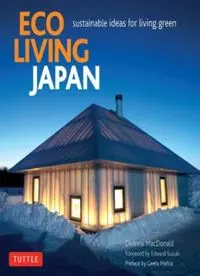
Eco Living Japan: Sustainable Ideas for Living Green PDF
Preview Eco Living Japan: Sustainable Ideas for Living Green
ECO LIVING JAPAN Sustainable Ideas for Living Green Deanna MacDonald Foreword by Edward Suzuki Preface by Geeta Mehta TUTTLE Publishing Tokyo | Rutland, Vermont | Singapore CONTENTS Foreword by Edward Suzuki Preface by Geeta Mehta The Sustainable Japanese House: Past, Present and Future CHAPTER 1 BORROWED LANDSCAPES Putting Nature in the Design HOUSE IN KITA-KAMAKURA HOUSE IN KOMAE HOUSE IN NARA HOUSE IN RAIZAN FOREST HOUSE IN TATESHINA GREEN CURTAINS THE MULTIPURPOSE ENGAWA CHAPTER 2 REINVENTING TRADITION Towards a More Sustainable Future HOUSE IN NAGAHAMA HOUSE OF MAPLE LEAVES KOTOBOSHIKAN MÊME MEADOWS MINI STEP HOUSE KATSURA IMPERIAL VILLA PASSIVE QUALITIES CHAPTER 3 ‘SMART’ GREEN Innovation, Technology and Sustainability PASSIVE HOUSE KARUIZAWA ONJUKU BEACH HOUSE A-RING HOUSE THE RISE OF THE DESIGN ECO PREFAB CHAPTER 4 REUSE, RENEW, RECYCLE, RENOVATE Alternatives to a Throwaway Culture OLD JAPANESE TIMBER HOUSE RENOVATION SHINMACHI HOUSE ARCHITECTURE OF THE PEOPLE: URBAN AND RURAL CHAPTER 5 SUSTAINABLE JAPAN ABROAD The International Impact of Japanese Design KONISHI GAFFNEY HOUSE MJÖLK HOUSE SUMMER RETREAT SÆVIK A1 HOUSE CHARRED WOOD CLADDING THE WABI SABI AESTHETICS OF THE TEAHOUSE Architects and Designers Resource Guide Photo Credits Acknowledgments Foreword In the old days, the Japanese wisely employed the concept of shakkei, meaning ‘borrowed scenery’, to enlarge and enrich their rather small piece of property by taking in the neighboring vista as part of their own. Unfortunately, this practice is fast disappearing in dense urban environments where many seek privacy rather than connection. As a result, I have been often asked to design defensively. Over time, I have developed a pattern of design I call ‘Interface’, whereby a strong demarcation, such as a fence or a screen, is made at the site boundary. Behind this screen is a cushion of green, usually bamboo. This combination of screen and green is Interface, an intermediate space between inside and out. Looking back at my experiences, I realize that what I had cultivated was not wholly new but had its roots in traditional Japanese architecture. Engawa, the corridor running around the periphery of a house, is central to traditional Japanese design. It is neither outside nor inside but is simply an interface between two worlds. To my happy surprise, I discovered that what I had come up with was nothing more than a modernized version of the traditional engawa. I began to realize, moreover, that there was a wealth of other design vocabulary from the past that I could learn from and apply in modern design. If we could only capture the wisdom of traditional Japanese daily living and translate that into our contemporary lifestyle, then there would be so much that could be accomplished using new materials, technology and design! Since this realization, my private practice, Edward Suzuki Associates, has been applying this centuries-old traditional Japanese architectural know-how, particularly in our house designs. Since 1945, Japan has, unfortunately, abandoned these traditions, losing the qualities inherent in the old ways, to embrace Modernism. As such, at my practice we are now relearning and reapplying the principles that once made Japanese architecture so successful. Such a procedure, however, is not unique to my office, but is becoming increasingly prevalent generally. The following are examples of traditional wisdom from which we try to borrow to achieve sustainable, healthy and comfortable homes: Engawa, as mentioned, is the peripheral corridor that runs around a traditional Japanese house. It is the intermediate space. In the summer, sliding partitions are removed to allow cross-ventilation and connect inside and out. In the winter, storm doors and shoji screens are returned to increase thermal insulation and minimize heat loss. Tsukimidai is a moon-gazing terrace, an interface between heaven and earth, a nostalgic planetarium and a form of borrowed scenery on a grand scale. Tsuboniwa is a pocket garden and interface between inside and outside. Some are as small as a square meter, but nonetheless can do wonders, allowing in natural sunlight and breezes while pleasing the soul. Tokonoma is a stage in a tearoom, usually one tatami in size, where seasonal art, such as a floral arrangement, is displayed, thus bringing the outside in. Irori is a hearth where not only food but, more importantly, bodies and souls are warmed. Hisashi, or deep eaves, allow winter sun to penetrate but prevent the scorching sun and rain from entering the interior. Shoji and kohshi, louver screens of wood, bamboo or reeds, soften harsh natural sunlight to diffuse gently inside. Tsuufuu, or natural cross-ventilation, carries gentle breezes throughout the house by means of windows and doors to minimize use of air-conditioning and energy. Uchimizu is literately ‘scattering water’ in front of and around a house to tame summer heat. While Japan prides itself today in its development of futuristic high- tech innovations, it also has a vast, environmentally wisdom-rich inheritance from which future generations can benefit and prosper. Edward Suzuki
